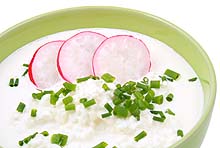What Are the Health Benefits of
Cottage Cheese?

The term "cottage cheese" is believed to have originated because the simple cheese was usually made in cottages from any milk leftover after making butter. The term was first used in 1848.
Let us assume you have a 226 g cup of cottage cheese, low fat with 1% milk fat. What are the nutrients you're getting from it?
Cottage cheese has 163 calories for the above-specified serving. The actual fat content is only about 2 g, of which only 1 g is saturated. So that is most certainly good news.
If you're looking for proteins, then cottage cheese is the thing for you. The aforementioned chunk of cottage cheese will lend you about 28 g of proteins, which is a pretty good amount of protein. Apart from the above, cottage cheese is also rich in phosphorus, riboflavin, selenium, calcium and vitamin B12. The downside is that cottage cheese is very high in sodium.
Low–fat cottage is ideal for quick and tasty salads, and as a dip with crudités. Well-drained cottage cheese also makes a good filling for pitta bread pockets and tortilla wraps — just add some fresh salad vegetables or roasted peppers and mushrooms.
For variety, add these to your cottage cheese:
- A couple of tablespoons of cooked, diced chicken.
- A slice of chopped, lean, cooked ham or turkey (on the bone, not re-formed).
- Two tablespoons of cooked, chopped prawns (defrosted if frozen).
- A tablespoon of chopped pineapple (you can use tinned in juice, drain first).
- Two tablespoons of finely chopped red and/or green pepper.
|